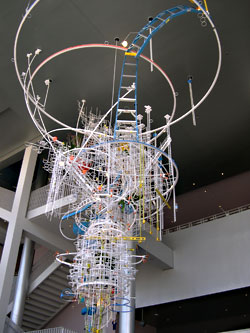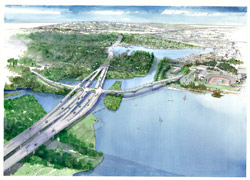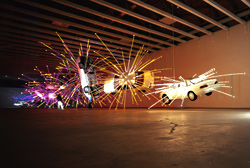If the artists and dreamers of the local arts community had their way, the national media would swoop down and declare Seattle a Major Cultural Mecca, featuring it prominently and regularly in their coverage. Visitors would come from near and far, wallets at the ready, to buy unique and extremely collectible Seattle art.
First Thursdays would fill galleries with people clamoring for more than just free wine. Little red dots (denoting “Sold!”) would litter not only the paintings of Michelle Forsyth and Denzil Hurley, but works by underappreciated artists such as Dawn Cerny and Cat Clifford.
The city would require developers to build one affordable live/work space for every upscale condo put on the market. There would be an endless fount of generous grant money from Artist Trust and an array of new sources. Artists could actually afford to give up their day jobs, complete their work—and eat, too! The Seattle Arts Commission would be staffed by visionary and knowledgeable art lovers. The mayor would declare art the number one priority in the city.
And here’s where you come in: Ordinary people would buy art!
This is the earful I heard when I surveyed over 20 artists, art dealers, curators, and critics about Seattle’s arts scene. I asked eight questions about local trends, institutions, artists, and conditions, and received a range of answers that were thoughtful, sometimes humorous, and always passionate. In future editions of Seattle Weekly, we’ll delve into some of the issues they raised. In the meantime, here is a glimpse of what their Artopia would look like.
Many would like to see Seattle Art Museum offer bold, provocative, memorable shows that would leave people talking for months after they’ve closed. And many, like Howard House director Billy Howard, think, “The Frye and Robin Held are one of the best things going. The Frye is such a beautiful space, and Robin is doing ambitious shows.”
The city would have more art exhibit spaces like Suyama Space, which “offers the escape and room to actually contemplate the artwork that it contains [and] allows a single artist to install a single piece of work,” says Annie Han of Lead Pencil Studio, which recently installed a thought-provoking exhibit there. And we’d see more places like Western Bridge—”a venue that is architecturally and conceptually inspiring because it shows us important work from outside our community that contributes to the national and international contemporary art dialogue,” says Jess Van Nostrand, curator at Joe Bar in Capitol Hill—and like the avant-garde co-op gallery SOIL, “a blessedly mutating organism. You can’t second-guess where it will go,” according to longtime gallery owner Greg Kucera.
The Tashiro-Kaplan Building would continue to fill up with edgy galleries and artists, shifting the Seattle art epicenter eastward, revitalizing a once desolate corridor. It’s “a godsend to one of the areas in town that really needed an infusion of 24-hour residents,” says Kucera, whose gallery is located one block away.
The local news media would devote endless time, space, and money to covering the visual arts scene. Art critics would sign 20-year contracts requiring that they stay put and become experts on every emerging and descending artist, following their work throughout their careers.
There would be more public art like the three great stones of Michael Heizer’s Adjacent, Against, Upon at Myrtle Edwards Park. “It’s timeless, monumental, and endlessly suggestive. But mostly it isn’t sappy!” says Gallery 110’s Molly Norris Curtis. And we’d see more work to equal Sarah Sze’s swirling sculptural installation at McCaw Hall: “fabulously inventive and wonderfully ‘blue collar’ amid the very chic, very upscale opera house,” says Kucera. On the other hand, Waiting for the Interurban would be on permanent hiatus, if some people had their way.
Arts education in the schools and for the public would be increased. There would be “an aggressive commitment to and concern for undergraduate and graduate arts education,” dreams Western Bridge’s Eric Fredericksen. And public officials would free up more dollars for arts and artists. “It’s about time the city and county realized that artists are crucial to the cultural fabric,” says Kucera.
This, of course, is not the reality. Arts funding, housing, and education are all at various stages of crisis, depending on who you ask. (And if you want to add your two cents, e-mail me at the address below.)
But if artists don’t dream, who will?








